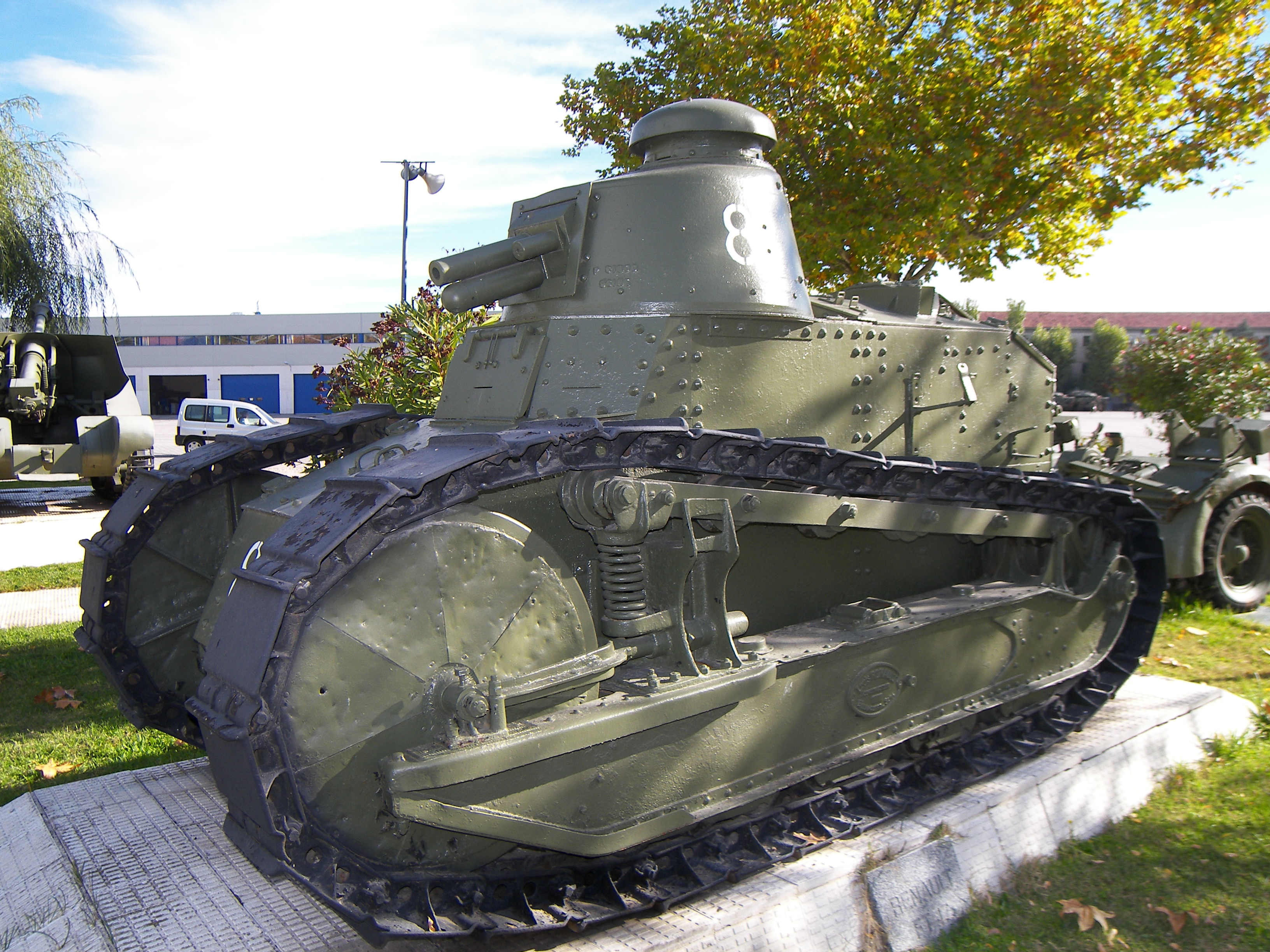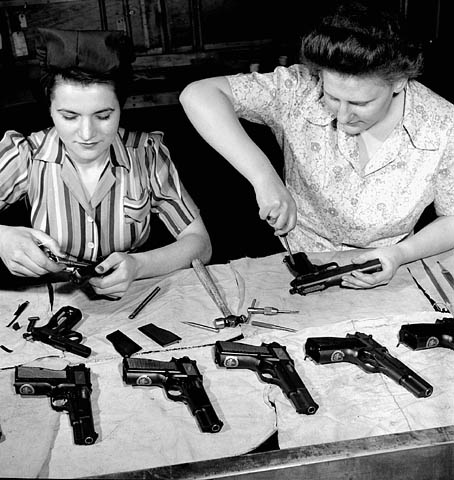|
SEPEWE
SEPEWE was a Polish arms industry syndicate. Established as a joint venture of the Polish government and 19 private companies of the arms industry, it became one of the largest arms dealerships of the 1920s and 1930s. Between 1926 and 1939 SEPEWE exported Polish and foreign-made military equipment to over 30 states, obtaining between 320 and 350 million zlotys. The company specialised in both surplus military equipment of World War I vintage and modern weapons produced by Polish factories. Equipment sold ranged from small arms to modern PZL.37 medium bombers. Name The full name of the syndicate was "Eksport Przemysłu Obronnego SEPEWE sp. z o.o." - "Export of Arms Industry SEPEWE, Co. Ltd.". The SEPEWE name itself was initially an abbreviation meaning "Arms Industry Export Syndicate" ( pl, Syndykat Eksportu Przemysłu Wojennego), but the full name was rarely used. History Although after World War I and the Polish-Bolshevist War Poland inherited a sizeable arms industry, the ... [...More Info...] [...Related Items...] OR: [Wikipedia] [Google] [Baidu] |
Polish Arms Sales To Republican Spain
Polish arms sales to Republican Spain took place between September 1936 and February 1939. Politically Poland did not support any of the Spanish Civil War sides, though over time the Warsaw government increasingly tended to favor the Nationalists; sales to the Republicans were motivated exclusively by economic interest. Since Poland was bound by non-intervention obligations, Polish governmental officials and the military disguised sales as commercial transactions mediated by international brokers and targeting customers in various countries, principally in Latin America; there are 54 shipments from Danzig and Gdynia identified. Most hardware were obsolete and worn-out second-rate weapons, though there were also some modern arms delivered; all were 20-30% overpriced. Polish sales amounted to $40m and constituted some 5-7% of overall Republican military spendings, though in terms of quantity certain categories of weaponry, like machine-guns, might have accounted for 50% of all arms ... [...More Info...] [...Related Items...] OR: [Wikipedia] [Google] [Baidu] |
Arms Industry
The arms industry, also known as the arms trade, is a global industry which manufactures and sells weapons and military technology. It consists of a commercial industry involved in the research and development, engineering, production, and servicing of military material, equipment, and facilities. Arms-producing companies, also referred to as arms dealers, or as the military industry, produce arms for the armed forces of states and for civilians. Departments of government also operate in the arms industry, buying and selling weapons, munitions and other military items. An arsenal is a place where arms and ammunition - whether privately or publicly owned - are made, maintained and repaired, stored, or issued, in any combination. Products of the arms industry include guns, artillery, ammunition, missiles, military aircraft, military vehicles, ships, electronic systems, military communications, night-vision devices, holographic weapon sights, laser rangefinders, laser sights, ... [...More Info...] [...Related Items...] OR: [Wikipedia] [Google] [Baidu] |
Second Spanish Republic
The Spanish Republic (), commonly known as the Second Spanish Republic (), was the form of government in Spain from 1931 to 1939. The Republic was proclaimed on 14 April 1931, after the deposition of Alfonso XIII, King Alfonso XIII, and was dissolved on 1 April 1939 after surrendering in the Spanish Civil War to the Nationalist faction (Spanish Civil War), Nationalists led by General Francisco Franco. After the proclamation of the Republic, Provisional Government of the Second Spanish Republic, a provisional government was established until December 1931, at which time the Spanish Constitution of 1931, 1931 Constitution was approved. During this time and the subsequent two years of constitutional government, known as the First Biennium, Reformist Biennium, Manuel Azaña's executive initiated numerous reforms to what in their view would modernize the country. In 1932 the Jesuits, who were in charge of the best schools throughout the country, were banned and had all their propert ... [...More Info...] [...Related Items...] OR: [Wikipedia] [Google] [Baidu] |
Kropatschek
A Kropatschek is any variant of a rifle designed by Alfred von Kropatschek. Kropatschek's rifles used a tubular magazine (constructed of nickel-plated steel) of his design, of the same type used in the Japanese Murata Type 22 and the German Mauser Gewehr 1871/84. While designed for black powder, the Kropatschek action proved to be strong enough to handle smokeless powder. The Kropatschek was the basis for the French Lebel M1886. Variants Austria-Hungary: * ''Gendarmerie Repetier-Karabiner M1881'': 11 mm Gendarmerie Carbine (also known as M1874/81); *''Kropatschek Torpedo Boats Gewehr M1893'': 8 mm Navy Rifle for Torpedo boat crews. France: * ''Fusil de Marine Mle 1878'': 11 mm Navy Rifle; * ''Fusil d'Infanterie Mle 1884'': 11 mm Infantry Rifle; * ''Fusil d'Infanterie Mle 1885'': 11 mm Infantry Rifle. Portugal: * ''Espingarda de Infantaria 8 mm m/1886'': 8 mm Infantry Rifle; * ''Carabina de Caçadores 8 mm m/1886'': 8 mm Ligh ... [...More Info...] [...Related Items...] OR: [Wikipedia] [Google] [Baidu] |
Fusil Gras Mle 1874
The Fusil Modèle 1874 or Gras was the French Army's primary service rifle from 1874 to 1886. Designed by Colonel Basile Gras, the Gras was a metallic cartridge adaptation of the single-shot, breech-loading, black powder Chassepot rifle. It was developed from 1872 to 1874 as a response to the German adoption of the Mauser Model 1871 metallic cartridge rifle. Modified in 1880 as the M80 with an improved breechblock and in 1914 as the M14 to accommodate the 8×50mmR Lebel smokeless powder cartridge, the Gras was replaced as the standard-issue service rifle by the Lebel in 1886. Description Converted from the Chassepot, the Gras was in caliber and used black powder centerfire metallic cartridges with a bullet over a charge. It was a robust and hard-hitting single-shot weapon. Additionally it had a triangular-shaped Model 1874 "Gras" sword bayonet. The Gras rifle was replaced from 1886 by the Lebel rifle. Development The Gras was manufactured in response to the development of ... [...More Info...] [...Related Items...] OR: [Wikipedia] [Google] [Baidu] |
Mannlicher M1895
The Mannlicher M1895 (german: link=no, Infanterie Repetier-Gewehr M.95, hu, Gyalogsági Ismétlő Puska M95; "Infantry Repeating-Rifle M95") is a straight pull Bolt action, bolt-action rifle, designed by Ferdinand Mannlicher, Ferdinand Ritter von Mannlicher that used a refined version of his revolutionary straight-pull action bolt, much like the Mannlicher M1890 carbine. It was nicknamed the ''Ruck-Zuck-[Gewehr]'' by Austrian troops (ruck-zuck spoken as "roock-tsoock", in common language meaning "back and forth [rifle]") and "Ta-Pum" by Italian troops who wrote a song (:it:Tapum (canzone), it) about it during World War I. The primary producers were the OEWG in Steyr, and FÉG in Budapest. Originally they were chambered for the round-nosed 8×50mmR Mannlicher, 8×50mmR cartridge, but almost all were rechambered to accept the more powerful spitzer 8×56mmR cartridge in the 1930s. Method of Operation The M1895 is unusual in employing a straight-pull bolt action, as opposed to ... [...More Info...] [...Related Items...] OR: [Wikipedia] [Google] [Baidu] |
Lee–Enfield
The Lee–Enfield or Enfield is a bolt-action, magazine-fed repeating rifle that served as the main firearm of the military forces of the British Empire and Commonwealth during the first half of the 20th century, and was the British Army's standard rifle from its official adoption in 1895 until 1957. The WWI versions are often referred to as the "SMLE", which is short for the common "Short, Magazine, Lee–Enfield" variant. A redesign of the Lee–Metford (adopted by the British Army in 1888), the Lee–Enfield superseded the earlier Martini–Henry, Martini–Enfield, and Lee-Metford rifles. It featured a ten-round box magazine which was loaded with the .303 British cartridge manually from the top, either one round at a time or by means of five-round chargers. The Lee–Enfield was the standard issue weapon to rifle companies of the British Army, colonial armies (such as India and parts of Africa), and other Commonwealth nations in both the First and Second World Wars (suc ... [...More Info...] [...Related Items...] OR: [Wikipedia] [Google] [Baidu] |
Lebel Rifle
The Lebel Model 1886 rifle (French: ''Fusil Modèle 1886 dit "Fusil Lebel"'') also known as the ''"Fusil Mle 1886 M93"'', after a bolt modification was added in 1893, is an 8 mm bolt-action infantry rifle that entered service in the French Army in 1887. It is a repeating rifle that can hold eight rounds in its fore-stock tube magazine, one round in the elevator plus one round in the chamber; equaling a total of ten rounds held. The Lebel rifle has the distinction of being the first military firearm to use smokeless powder ammunition. The new propellant powder, "''Poudre B''," was nitrocellulose-based and had been invented in 1884 by French chemist Paul Vieille. Lieutenant Colonel Nicolas Lebel contributed a flat nosed 8 mm full metal jacket bullet ("''Balle M''," or "''Balle Lebel''"). Twelve years later, in 1898, a solid brass pointed ( spitzer) and boat-tail bullet called "''Balle D''" was retained for all 8mm Lebel ammunition. Each case was protected against acciden ... [...More Info...] [...Related Items...] OR: [Wikipedia] [Google] [Baidu] |
Berthier Rifle
The Berthier rifles and carbines were a family of bolt-action small arms in 8mm Lebel, used in the French Army, and French Colonial Forces, from the 1890s to the beginning of World War II (1940). After the introduction of the Lebel rifle in 1886, the French Army wanted a repeating carbine using the same ammunition as the Lebel to replace their single shot carbine based on the Gras rifle. At the time, many armies based their carbines on their standard rifle model, however the Lebel rifle's tube magazine made it difficult to follow this approach. The Modele 1890 Berthier Cavalry Carbine addressed this issue by combining a modified Lebel action with an en-bloc clip magazine. With its successful cavalry introduction, the Berthier would go on to be produced in many different carbine and full-length rifle versions. History and usage The Berthier was originally introduced as a partial replacement for the French 1886 Lebel rifle. The Lebel, a revolutionary concept at the time of its int ... [...More Info...] [...Related Items...] OR: [Wikipedia] [Google] [Baidu] |
Kb Wz
KB, kB or kb may stand for: Businesses and organizations Banks * KB Kookmin Bank, South Korea * Kaupthing Bank, Iceland * Komerční banka, Czech Republic * Kasikornbank, Thailand * Karafarin Bank, Iran Libraries * National Library of Sweden ( sv, links=no, Kungliga biblioteket) * National Library of the Netherlands ( nl, links=no, Koninklijke Bibliotheek) Sport * Kalix BF, a Swedish bandy club * Kjøbenhavns Boldklub, a sports club, Copenhagen, Denmark Other businesses and organizations * KB Home, a US house builder * KB Lager, Australia * KB Toys, US * K&B, a New Orleans, Louisiana, US drugstore * Druk Air (IATA code: ''KB''), Bhutan airline People * Kevin Bartlett (Australian rules footballer) (born 1947) * KB (rapper) (born 1988), Kevin Elijah Burgess * KB Killa Beats (born 1983), Zambian record producer Science and technology Biology * Kilo-base pair (kb or kbp), length of D/RNA molecule Computing * Kilobit (kb), 1,000 bits * Kilobyte (kB), 1,000 bytes * Kn ... [...More Info...] [...Related Items...] OR: [Wikipedia] [Google] [Baidu] |
Gewehr 98
The Gewehr 98 (abbreviated G98, Gew 98, or M98) is a German bolt-action rifle made by Mauser, firing cartridges from a five-round internal clip-loaded magazine. It was the German service rifle from 1898 to 1935, when it was replaced by the Karabiner 98k, a shorter weapon using the same basic design. The Gewehr 98 action, using a stripper clip loaded with the 7.92×57mm Mauser cartridge, successfully combined and improved several bolt-action engineering concepts which were soon adopted by many other countries, including the United Kingdom, United States, and Japan. The Gewehr 98 replaced the earlier Gewehr 1888 as the main German service rifle. It first saw combat in the Chinese Boxer Rebellion and was the main German infantry service rifle of World War I. The Gewehr 98 saw further military use by the Ottoman Empire and Nationalist Spain. History The Gewehr 98 was introduced into German military service in 1898, replacing the Gewehr 1888. The bolt-action design was the lates ... [...More Info...] [...Related Items...] OR: [Wikipedia] [Google] [Baidu] |







